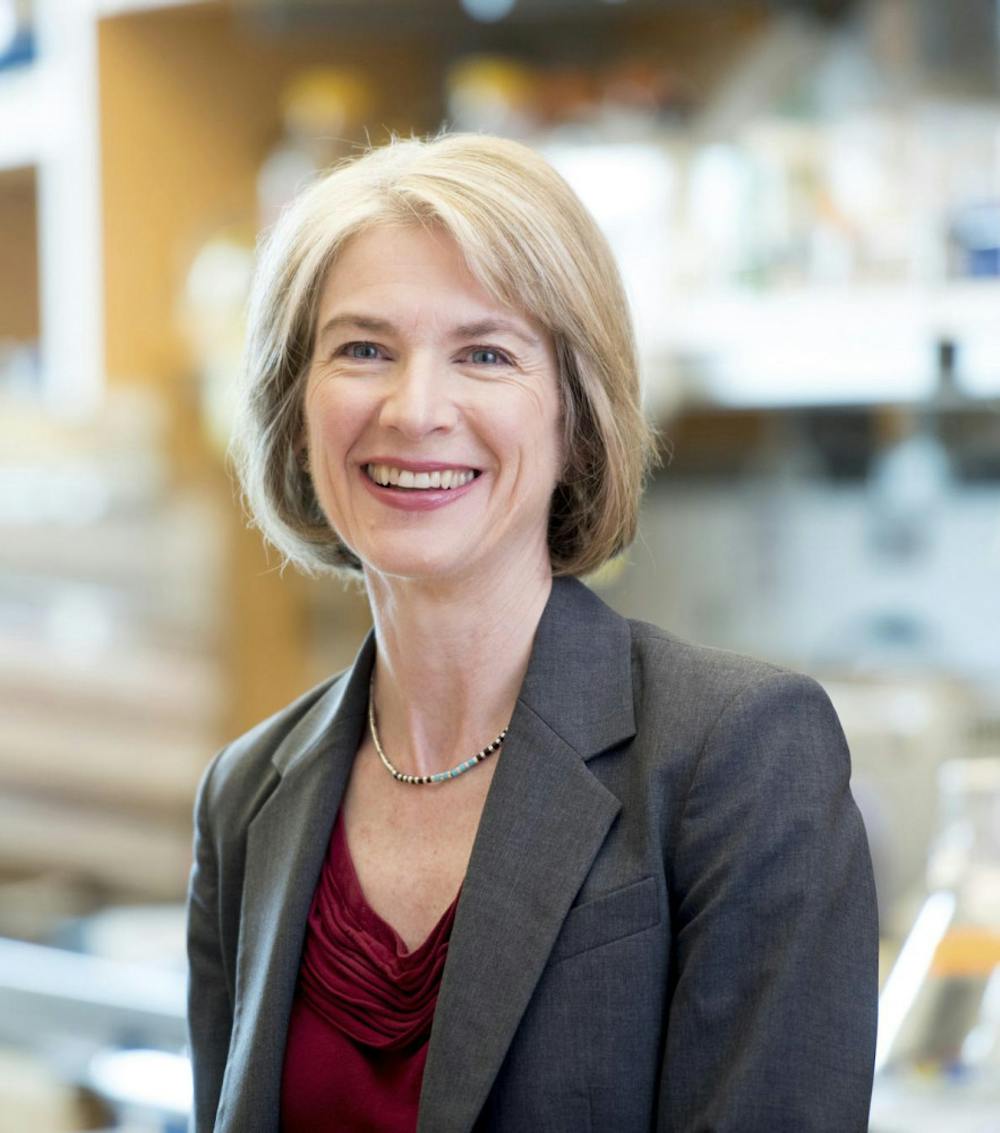Nobel Prize winner Jennifer Doudna, who co-invented CRISPR-Cas9 genome editing technology, joined President Christina Paxson P’19 for a virtual conversation on CRISPR’s wide-ranging applications and its ethical implications in medicine and beyond.
Doudna and collaborator Emmanuelle Charpentier received the 2020 Nobel Prize in Chemistry for their pioneering invention of CRISPR technology, which modifies DNA with novel precision and is globally recognized as a revolutionary development in science.
The event, attended by more than 800, was the inaugural lecture in the Lemley Family Leadership Lecture Series, which was established in 2020 through a gift from Wayne C. Lemley ’80 to feature exceptional intellectual leaders that “inform, challenge and educate” the Brown community, said Provost Richard Locke P’18 in a Feb. 25 news release.
Doudna discovered CRISPR unexpectedly while examining how bacteria fight viral infections.
When a bacterial cell with a CRISPR sequence in its DNA is infected by a virus, the cell acquires a piece of the DNA from the virus and stores it in the CRISPR part of its genome, Doudna explained. The cell can use RNA copied from the stored DNA, along with a tracer molecule and the Cas9 protein, to search for a sequence that matches the segment originally taken from the virus.
When this match is found, the cell uses the Cas9 protein to cut the DNA like a pair of genomic scissors. This cut triggers rapid destruction of viral DNA in bacteria, effectively creating immunity “in real time” to viruses, Doudna said.
By studying the mechanisms behind this bacterial defense system, Doudna’s lab was able to create a single molecule of RNA that provides both the directions for Cas9 to find certain DNA sequences and the information for its assembly with the Cas9 protein.
Though earlier technologies had allowed scientists to make double-stranded cuts in DNA at specific locations, CRISPR’s “simplicity, of having a single protein that is easily reprogrammed with RNA molecules, turned this into a tool that many labs quickly adopted (for) modifying DNA in human cells and many other types of organisms,” Doudna said.
CRISPR’s applications in curing genetic diseases, such as sickle cell anemia, have “generated a lot of excitement in the field,” Doudna said. Because CRISPR can edit genomes, it can be used to target the gene that creates the form of mutated hemoglobin responsible for sickle cell disease. The first sickle cell patient received CRISPR-based therapy in 2019 and has seen successful results. “This is not a fantasy,” Doudna said.
But while it holds great therapeutic potential, CRISPR technology could be used to make heritable genetic modifications to embryos or sperm cells, opening “the door to many potential risks and ethical concerns,” Doudna added.
Current research is working to move CRISPR technology into a realm where it will be “effective,” “safe,” and “importantly, ultimately affordable,” Doudna said.
The CRISPR-based therapy for sickle cell disease currently costs more than a million dollars. To make genome editing more accessible, Doudna emphasized the importance of the method used to deliver editing enzymes like Cas9 to cells in the patient’s body. “One of the keys to (accessibility) is finding ways to deliver Cas9 in a simpler package that doesn't require things like bone marrow transplantation,” but could still be delivered to existing cells in the body, she said.
Researchers in Doudna’s lab have developed an effective delivery strategy: using engineered HIV viral particles to deliver the gene editors — the CRISPR Cas9 protein and its RNA guide — into mixed populations of T-cells, white blood cells that are key actors in the body’s immune response.
They determined that these engineered viral particles were able to successfully differentiate between two types of T-cells and carry out gene editing for one designated type — “a great demonstration of what we hope to be able to do much more broadly in the future,” Doudna said.
Doudna’s lab, which has focused on research addressing the COVID-19 pandemic over the past year, has found that CRISPR’s applications also extend to diagnosing COVID-19.
Applying CRISPR to detecting COVID-19 requires the use of a different cutting enzyme, Cas13. Unlike Cas9, which cuts DNA, the Cas13 protein randomly cuts RNA, which composes COVID-19 viral particles. The lab found that when Cas13 is coupled with a fluorescent reporter, a fluorescent signal is released once Cas13 begins cutting, creating a “molecular diagnostic” for the presence of COVID-19.
Since this kind of diagnostic detects viral RNA directly instead of through a DNA intermediate, as is the case with current methods, it has potential to be a faster alternative. An ongoing partnership with the company Wainamics aims to create tiny sensors that use the CRISPR Cas13 to quickly detect COVID-19 RNA in contexts outside of testing sites, Doudna said.
“I wanted to share a big picture of what this technology is enabling,” and the science behind it, to appeal to both scientists and non-specialists in the audience, Doudna told The Herald in an interview.
As the CRISPR field has become more popular with researchers, Doudna’s lab is focusing on “the areas where our lab has unique capabilities,” specifically genome editing delivery, which is “a big bottleneck right now,” she said.
Doudna also recently made the decision as president of the Innovative Genomics Institute at University of California, Berkeley and University of California, San Francisco to focus the institute’s work on using genome editing to combat climate change. For instance, CRISPR technology can manipulate the genome of plants and microbes in soil and water to increase their capacity to store carbon dioxide.
She hopes attendees of the lecture will leave with “a kind of high-level understanding” of CRISPR technology and “feel hopeful” for its possibilities, rather than afraid.
“CRISPR is the result of fundamental curiosity-driven science,” Doudna said. “I encourage students to follow their interests, follow their passions, and even if you think it's in a narrow (field), you never know where the next fundamental discoveries are going to come from.”

ADVERTISEMENT




